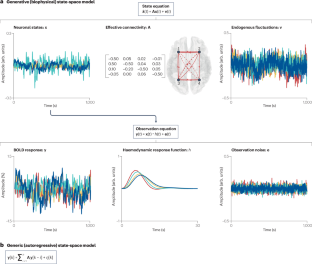定向大脑连接的结构信息模型
IF 28.7
1区 医学
Q1 NEUROSCIENCES
引用次数: 0
摘要
了解一个大脑区域如何在体内对另一个大脑区域施加影响,受到用于推断或预测定向连接的模型的严重限制。尽管这种神经相互作用依赖于大脑的解剖结构,但在宏观尺度上,结构(或解剖)连接是否对定向连接模型提供有用的约束仍不清楚。在这里,我们回顾了这个问题的研究现状,强调了基于推理的有效连接和基于预测的定向功能连接之间的关键区别。我们探索了将结构连通性集成到有向连接模型中的方法:通过先验分布、状态空间模型中的固定参数和结构学习算法的输入。尽管有证据表明整合结构连通性大大改善了定向连通性模型,但缺乏可靠性和样本外有效性的评估。我们总结了未来研究的策略,以解决当前的挑战,并确定推进结构连接和定向连接的整合的机会,最终提高对大脑健康和疾病的理解。本文章由计算机程序翻译,如有差异,请以英文原文为准。


Structurally informed models of directed brain connectivity
Understanding how one brain region exerts influence over another in vivo is profoundly constrained by models used to infer or predict directed connectivity. Although such neural interactions rely on the anatomy of the brain, it remains unclear whether, at the macroscale, structural (or anatomical) connectivity provides useful constraints on models of directed connectivity. Here, we review the current state of research on this question, highlighting a key distinction between inference-based effective connectivity and prediction-based directed functional connectivity. We explore the methods via which structural connectivity has been integrated into directed connectivity models: through prior distributions, fixed parameters in state-space models and inputs to structure learning algorithms. Although the evidence suggests that integrating structural connectivity substantially improves directed connectivity models, assessments of reliability and out-of-sample validity are lacking. We conclude this Review with a strategy for future research that addresses current challenges and identifies opportunities for advancing the integration of structural and directed connectivity to ultimately improve understanding of the brain in health and disease. The influence anatomy exerts on communication between brain regions remains unclear. In this Review, Greaves et al. synthesize how methods of structural connectivity integration constrain inference-based or prediction-based models of directed connectivity to better understand how one brain region exerts control over another.
求助全文
通过发布文献求助,成功后即可免费获取论文全文。
去求助
来源期刊

Nature Reviews Neuroscience
NEUROSCIENCES-
自引率
0.60%
发文量
104
期刊介绍:
Nature Reviews Neuroscience is a multidisciplinary journal that covers various fields within neuroscience, aiming to offer a comprehensive understanding of the structure and function of the central nervous system. Advances in molecular, developmental, and cognitive neuroscience, facilitated by powerful experimental techniques and theoretical approaches, have made enduring neurobiological questions more accessible. Nature Reviews Neuroscience serves as a reliable and accessible resource, addressing the breadth and depth of modern neuroscience. It acts as an authoritative and engaging reference for scientists interested in all aspects of neuroscience.
 求助内容:
求助内容: 应助结果提醒方式:
应助结果提醒方式:


